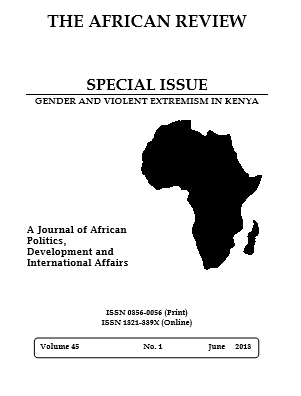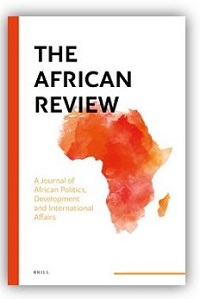Impact of Violent Extremism and Recruitment of Spouses on Widows in the Coastal Region of Kenya
Abstract
Radicalization1 and Violent Extremism (VE) 1 have been on an apparent increase across East Africa. This has partly been exacerbated by the ongoing insurgency of a myriad of militia groups, especially fanned by the Somalia-based militants €“ Al-Shabaab and the Islamic State of Iran and Syria (ISIS). In this light, there has risen a greater demand for fighters, especially men to join VE groups with its attendant ramifications on female spouses. In this regard, it is apparent that a lot of focus on the impact of VE and recruitment has been directed to the male recruits and violent extremists. There is a clear gap in literature on what is the impact of VE on widows, especially those whose spouses were recruited and got killed in the process and how do they cope. While it is clear that certain changes occur as a result of male spouses recruitment into VE groups and leaving their wives behind, especially to the category of men married before perceived recruitment, such changes have not been examined. Where such considerations have been done, they did not take into account widows of violent extremists as primary targets. It is against this background that the present study focused on the impact of VE and recruitment of male spouses on widows in the coastal region of Kenya and their coping mechanisms. In order to achieve this, a mixed methods approach was adopted. The study found out a plethora of negative impacts on widows of VE grouped into physical, economic, structural, psychosocial and emotional. With regard to coping mechanisms, the study found that widows of VE have developed livelihood, structural, spiritual, psycho-social and emotional support infrastructure to deal with the negative impacts.
Keywords: Violent Extremism, Widows of VE, Coping Mechanisms, Impact of VE on widows, Coast of Kenya.
Halimu S. Shauri
Associate Professor, Pwani University, E-mail: hshauri@yahoo.com
References
Andre, Le Sage (2014): "The Rising Terrorist Threat in Tanzania: Domestic Islamist Militancy and Regional Threats." 2014. Report. Institute for National Strategic Studies
Balasubramaniym, R. A. (2015): Evolving Role of Women. Journal of Women's Studies 15(2), 197-211.
Bayliss, Charlie (2016): "Islamic State Unveils First Ever Spokeswoman in Bid to Brainwash Girls to Join Death Cult", Daily Express, 18th August 2016.
Bombshell, Bloom and Bakker, Edwin (2006): Jihad Terrorists in Europe: Their Characteristics and the Circumstances in which they joined Jihad: An exploratory study; The Hague: Clingendael Institute, p.36.
Botha, A. (2014). Radicalisation in Kenya.Recruitment to al-Shabaab and the Mombasa Republican Council. Institute for Security Studies Papers, 2014(265), 28.
Carter, B. (2013). Women and violent extremism.GSDRC Helpdesk research report.
Government of Kenya, and United Nations Development Program. (2015). Government of Kenya and United Nations Development Program " Strengthen Community ' s Capacity Against Radicalisation and Violent Extremism in Kenya ."
Hassan, M. (2012): Understanding drivers of violent extremism: The case of Alshabaab and Somali Youth (27/2/2018; 8:20): https://ctc.usma.edu/understanding-drivers-of-violent-extremism-thecase-of-al-shabab-and-somali-youth/
ICG. (2016). Nigeria: Women and the Boko Haram Insurgency. Report n ° 242, ICG.
Institute of international relations and strategies. (2015). NORTHEASTERN KENYA: A Prospective Analysis, (December).
Kenya Transitional Justice Network. (2013). Truth Justice and Reconciliation Report. Nairobi.
Kruglanski, A. W. (2014). The Psychology of Radicalization and Deradicalization : How Significance Quest Impacts Violent Extremism, 35, 69 €“93. https://doi.org/10.1111/pops.12163
Marc, G. D. de Saint, Guglielminetti, L., Netten, J., Lacombe, S., Donk, M. van de, Galesloot, J., and Woltman, P. (2016). Handbook: Voices of victims of terrorism.
Mwaruvie, J. M. (2011). The Ten Miles Coastal strip : An Examination of the Intricate Nature of Land Question at Kenyan Coast, 1(20), 176 €“182.
Noor, H. M. (2015). Patriarchy, Extremism and Why We Can't Ignore Women. Retrieved from Allafrica: http://allafrica.com/stories/201510281193.html
Otieno, B. (2016). Secure all police stations , shift spying tactics , MPs urge state. The Star, p. 30.
Pressman, D.E. (2016). The Complex Dynamic Causality of Violent Extremism: Applications of the VERA-2 Risk Assessment Method to CVE Initiatives. In: Masys A. (eds) Disaster Forensics. Advanced Sciences and Technologies for Security Applications. Springer, Cham.
Ranstorp, M., and Hyllengren, P. (2013). Prevention of violent extremism in third countries: Measures to prevent individuals joining armed extremist groups in conflict zones. Sweden.
Rourke, A. L. (2009). What's special about female Suicide Terrorism. Security Studies, 681-718.
Saltman, Erin Marie and Smith, Melanie (2015): "Till Martyrdom Do Us Part": Gender and the ISIS Phenomenon, Institute for Strategic Dialogue,
Shauri, H. S. andObeka, M. B (2017): Breaking the Cultural Barriers of Gender within the Islamic Context at the Coastal Region of Kenya in Meeting of Cultures at the Kenyan Coast; By Kimani Njoguand Irene Cege (Eds.):Twaweza Communication (Working towards a better world).
Shauri, H. S. and Wechuli, W. S (2017): Radicalization and violent extremism at the coast of Kenya: Powerful Voices of co-existence, Are they being heard? In Meeting of Cultures at the Kenyan Coast; By Kimani Njoguand Irene Cege (Eds.): Twaweza Communication (Working towards a better world).
Sindh, O. (2015). Socio-Psychological Impacts Of Religious Extremism On Women Of Sindh , Pakistan Socio-Psychological Impacts Of Religious Extremism On Women, (February 2017). https://doi.org/10.9790/0837- 20574246
Sjoberg Laura (2013): Gendering Global Conflict: Towards Feminist Theory of War; New York, NY: Columbia University Press, p.5.
United Nations. (2013). The role of women in terrorism, conflict and violent extremism: Lessons from the United Nations and International actors by Naureen Chowdhury Fink, Rafia Barakat and Liat Shetret; Centre on Global Counterterrorism Cooperation (CGCC), Goshen, SA.http://www.globalcenter.org/wpcontent/uploads/2013/04/NCF_RB_LS_policybrief_1320.pdf.
Winterbotham Emily and Pearson Elizabeth, 2016: Different Cities, Shared Stories: A five-country study challenging assumptions around Muslim women and CVE interventions; The RUSI Journal: Routladege; Taylor and Francis Group.
World Bank. (2016). Jobs for Youth. Unemployment, youth total (% of total labor force ages 15-24) https://data.worldbank.org/indicator/SL.UEM.1524.ZS?locations=BN (2/11/2017: 6:03pm). (Modeled ILO estimates)
Downloads
Published
Issue
Section
License
Copyright © by Department of Political Science and Public Administration, University of Dar es Salaam
All rights reserved. No part of this publication may be reproduced or transmitted in any form or by any means, electronic or mechanical, including photocopying, recording, or any information storage or retrieval system, without permission in writing from the publisher, except for short extracts in fair dealing, for research or private study, critical scholarly review or discourse with an acknowledgement.
The African Review: A Journal of African Politics, Development and International Affairs [ISSN 0856-0056 (Print) & ISSN 1821-889X (Online)] is published bi-annually, June and December by the Department of Political Science and Public Administration, University of Dar es Salaam, P.O. Box 35042 €“ Dar es Salaam €“ Tanzania



